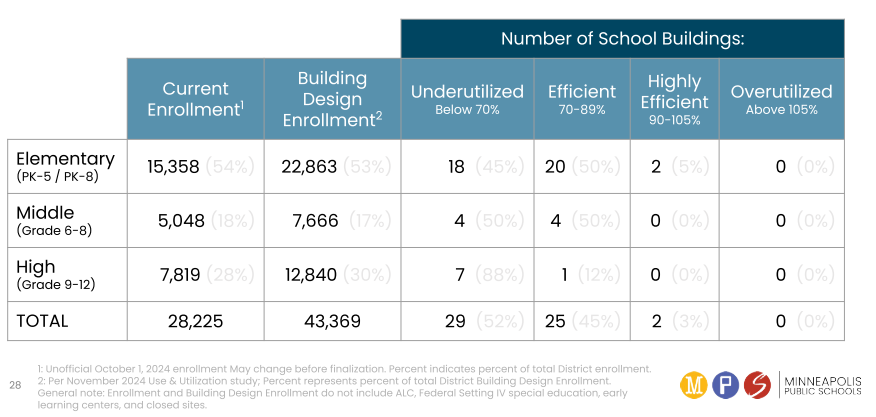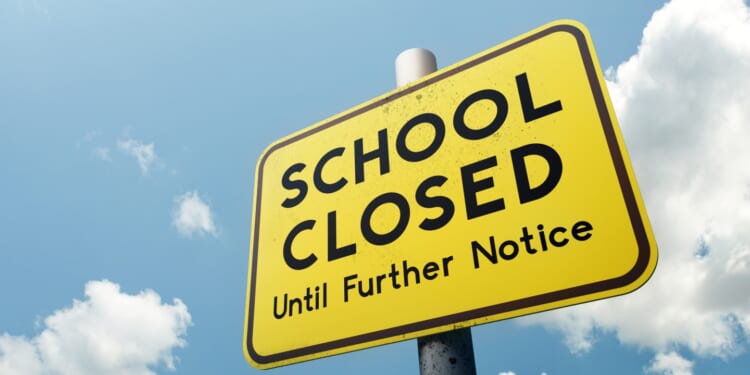In an October 14 Minneapolis Public Schools (MPS) school board meeting, the board voted to pass a resolution that formally requested Superintendent Dr. Lisa Sayles-Adams to provide recommendations regarding, in part, the consolidation, closing, and repurposing of school programs and sites.
Parents shouldn’t expect bus routes to change anytime soon. Sayles-Adams has until April of 2026 to provide the recommendations, and there is currently no clear timeline as to when (or if) the recommendations must be implemented.
The path toward this board motion has been protracted and circuitous.
Bureaucracy Shrugged
Minneapolis Public Schools have been losing students over time, as families within the district increasingly choose charter or private schools — or leave the district altogether. Losses accelerated in the wake of the pandemic, as longer-than-most COVID restrictions kept the district locked down, social unrest in the summer of 2020 worried parents, and a 2022 three-week teacher strike left families uprooted. In a November 2024 meeting, the School Board noted that while there are 55,129 school aged children living in Minneapolis, only 28,255 (or 51 percent) are enrolled in an MPS school. The city of Minneapolis has seen shifting population numbers, too, with far fewer children present in the city in recent years due to an aging workforce and increased popularity of the suburbs. The Minneapolis Public School district expects that the number of children living in the city will continue to decline until 2029, when it will stabilize at 23,000 students.
The district has known that it is not financially stable since 2017. Minneapolis Public Schools currently has a $75 million budget deficit, which was, in part, predicted in a 2022 district memo that gave a comprehensive financial assessment to the district. While MPS cut some costs and raised class sizes in response to the memo, the results didn’t stave off continuous financial difficulty. Regarding the memo, the Minnesota Reformer notes that it presented an
analysis showing enrollment growth alone could not overcome the district’s structural inefficiencies resulting from operating many schools with small enrollments. At the time of the analysis, Anoka-Hennepin was operating 37 school buildings while enrolling about 37,000 students. Minneapolis was operating 61 buildings while enrolling about 29,000 students. Minneapolis had about half as many students per building as Anoka-Hennepin.
Some board members paid attention to the incoming crisis. In spring of 2023, then-Chair Sharon El-Amin asked then-Interim Superintendent Rochelle Cox to provide information to school board members regarding what El-Amin termed “school transformation,” or district building restructuring. The 2023 request was very similar in principle to the newly passed 2025 request. In the meeting, Cox said, “My team and I will take that back and get working on it right away.” No such document has ever materialized, and Cox has worked as an Assistant Superintendent in the Fridley school district since May of 2025.
However, a December 2023 board meeting reiterated the request, as the board passed a resolution “initiating a school transformation process” that the incoming Superintendent Dr. Lisa Sayles-Adams would have to fulfill. In June 2024, current Superintendent Dr. Lisa Sayles-Adams noted that “right-sizing the district” was a high priority for her, and planning would begin as soon as that year’s budget was passed.
In August of 2024, school board members attended a retreat to discuss potential district restructuring. No details of a plan or timeline were shared.
A building task force was created and presented their findings to the MPS board in November 2024.
In the recent October 14 meeting, school board member El-Amin summed up, in a tone of exhaustion, what many were thinking. “We started this in 2023…I think we have defined, redefined, went through, and it is time for us to really just get to work.”
Why school closings could improve quality of services
A more strategic allocation of buildings could transform the district. The November 2024 board report found that 52 percent of the buildings in the district were underutilized.

Every building has to be cleaned, decorated, and maintained meticulously, even if there are locked and empty classrooms. Underutilized buildings strain the district budget and mean that programs are often cut or moved to part-time to cope with a declining student population. Rather than simply giving children a larger classroom space, they actually inhibit the student experience.
Schools with declining enrollment may be unable to hire full-time drama, arts, or sports teachers. Students lose access to support services like supplemental tutoring, school counselors, or other nice-to-have services like school community liaisons. Sports are impacted as well. Some schools in Minneapolis are already sharing sports teams.
MPS also spends more on some groups than it receives from state or federal funding, like $17 million extra allocated this year for English Learner services. According to Minnesota Department of Education data, Minneapolis Public Schools has served high levels of English Learners for some time— in 2015, for example, 24.29 percent of students qualified as English Learners. The number has fluctuated in recent years, with 17.6 percent of students qualifying as English Learners in 2023, compared to 22.5 percent in 2025. The need for these specialized services isn’t new, meaning that district leaders need to focus on recent inefficiencies to understand why (and if) these programs are a culprit in the budget deficiency. If buildings were consolidated, specialized teachers for English Learner programs would no longer have to be spread out across the district.
School closures create community upheaval, but they can also be an opportunity for “spring cleaning.” Underperforming buildings, programs, and teachers can be set aside in favor of proven excellence. If done properly, the restructuring could become an avenue to lure back the students the district has formerly lost. In 2025, only 40.8 percent of Minneapolis’ students could read at grade level, and only 35.8 percent met mathematics expectations. Increasing the test score numbers is a strong first step towards increasing enrollment.
What happens next?
If past trends continue, it may be some time before there’s an actionable plan to consolidate MPS buildings. But faced with an immense budget shortfall, teachers who are currently threatening to strike, and a continuously declining student body, school board members might feel that their feet are held to the fire.
But it will likely take community action and repeated feedback in order to turn up the heat.
The recent October request that Superintendent Sayles-Adams provide recommendations for “school transformation” by April 2026 asked the Superintendent to form a plan for “Increasing enrollment to reach the sweet spot.” Board member Joyner Emrick objected to the vague phrasing of “sweet spot,” arguing that, according to the November 2024 building report, efficient building capacity was already defined at 70-89 percent. Emrick presented an amendment that would update the language to bring more precision to the request and ensure that future recommendations were immediately usable.
Other board members argued that the wording was purposefully vague, in order to allow the Superintendent team more flexibility in their recommendations. The amendment failed.
Emrick commented, “What’s going on with my co-directors who don’t want to take responsibility?”










